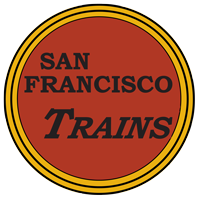Restoration at GGRM
Note: The project team involved with #4 at the Golden Gate Railroad Museum formed the nucleus of San Francisco Trains when it was established in 2005, such that the two could be considered synonymous. On this page, “we” technically refers to that project team until 2005.
The first order of business after the locomotive arrived at Hunter’s Point was determining if the boiler could be reconditioned to operation. A hydrotest found that the boiler was sound, but with the anticipated problems of a 75-year old locomotive. Then we removed the flues from the boiler and turned our attention to the frame and cylinders. That’s when we found the hole in the steam delivery port in the cylinder casting.
The wall of the delivery port used to be a full inch thick, but soot residue in the smokebox makes for a very destructive problem when rainwater turns it into a metal eating acid (if you’ve got a steam engine in your town park, make sure the smokestack gets covered to prevent this from happening). This was serious cause of concern, and the locomotive could not run unless this was repaired. In order to get to the repair, a full teardown was called for. The boiler would have to be removed from the frame.
Cylinder Repair, Plan A
Our initial repair to the rusted cylinder casting was to preheat and braze to the old cast iron. Here an electrical heating system is applied to provide a base working temperature for the welder. These pictures show these steps:
This repair failed a water pressure test and the brazing was ground off. We believe the carbon contamination to the metal and poor quality of the cast iron prevented an effective seal from being made.
Cylinder Repair, Plan B
With the brazing not taking to the cast iron we decided to remove the rusted area and cut into fresh metal and machine a matching piece. This would prove successful, it just took some time to design and implement.

The steam is delivered to the cylinders through the top of the saddle, and new pipes will be fabricated to match the parts Irv made. Here we have a Bridgeport milling machine head fixed to a bracket designed for this repair. A special cutting head that feeds outward was attached to the Bridgeport.
Frame & Wheel Repair
In 2002 volunteers finished the frame with gloss black paint and returned it to the inside of our shop. In 2003 we purchased new springs, cast new shoes and wedges, painted the driving wheels and most importantly completed the task of tramming the engine – a measuring process that assures the engine runs well on track. This followed welding repairs to the frame — donated by All Metals Welding– and the driving wheels repair — by Koffler Electric and the Golden Gate Railroad Museum Volunteers efforts over the last few years.


The bearing surfaces on all of the No. 4’s three axles were turned here at Koffler Electric in San Leandro. Their lathe is normally used to turn shafts of electrical generators for power plants. Thanks to Koffler Electric for donating a substantial portion of the work.
Eviction, Storage, and New Restoration Site
In 2005, the Golden Gate Railroad Museum was evicted from Hunter’s Point. The organization and most of its equipment moved to Niles Canyon, but State Belt No. 4 was put under the custody of San Francisco Trains in the hopes that we could find some place in the City to display it. Initially, the locomotive went into storage in South San Francisco, but this was short-lived and the engine was moved to a site next to the old Schlage Lock Building on the north end of the former Bayshore Yard.
In 2008, the developer of the Yard parcel permitted us to move our restoration to a concrete-and-asphalt pad right across from the Bayshore Roundhouse. The restoration continues here, and we hope to eventually give No. 4 a permanent home in the Roundhouse when the land is redeveloped.








